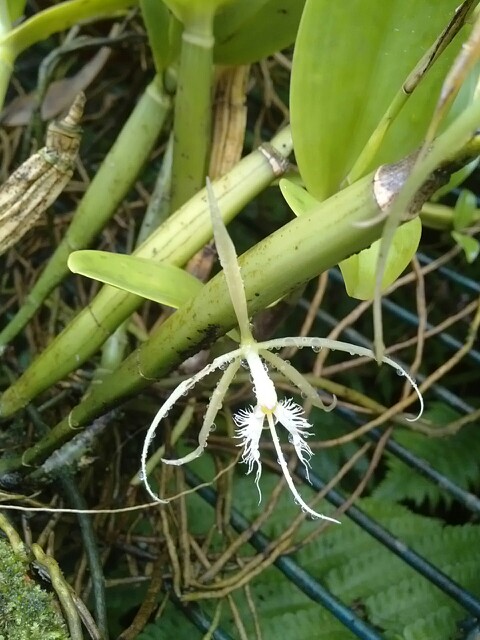

Epidendrum megalemmum Carnevali & G.A.Romero 2008 GROUP Coilostylis
Photo by © Hernan Ferrar Pereira Southwestern College Greenhouse Website
Drawing by © Jimenez, Hágsater & E.Santiago and The AMO Herbario Website







Common Name The Large Floral Bract Epidendrum [refers to the large, prominent floral bracts that cover the ovary, and eventually the fruit]
Flower Size 3.4" [9 cm]
Found in Puerto Rico, St. Thomas, Antigua, Guadeloupe and Martinique, northern Colombia, Venezuela and neighboring Guyana in dry areas at elevations of 50 to 280 meters as a medium sized, hot growing epiphyte or lithophyte with simple, covered in youth by 2 to 3 papyraceous sheaths, thickened into fusiform, heteroblastic, straight pseudobulbs carrying [1] 2 to 3, aggregate towards the apex of the pseudobulb, coriaceous, articulate, blade elliptic, acute leaves that blooms at any time of the year on a terminal, erect, without a spathe, peduncle laterally compressed, covered by 5 to 10 imbricating, conduplicate, acute bracts, progressively longer, 6.4 to 10" [16 to 25 cm] long, apical, produced from the mature pseudobulb, racemose, distichous, rachis terete, thin, straight to slightly sinuous, simultaneously 4 to 9 flowered inflorescence with 1/3-1/2 the length of the ovary and embracing it, oblong-triangular, conduplicate, acuminate, floral bracts and carrying resupinate, nocturnally fragrant flowers.
"Epidendrum megalemmum belongs to the GROUP Coilostylis which is characterized by the sympodial, caespitose plants, the stems forming a fusiform, heteroblastic pseudobulb, with an apical, racemose, distichous, inflorescence, the peduncle covered by large bracts, and flowers large, star-shaped, with long, narrow sepals and petals. The species is recognized by the deeply fimbriate-laciniate outer margin and the lateral lobes of the lip, the inflorescence which originates from the mature, fusiform, pseudobulb with 2 to 3 apical, leaves, rarely 1; the peduncle is covered by 5 to 10 imbricating, conduplicate, acute bracts, and the narrow petals, .08 to .128" [2.0 to 3.2 mm] wide. It closely resembles Epidendrum ciliare L. which is widely distributed from southeastern Mexico, through the Antilles, Central America and South America (Colombia, Venezuela, the Guianas, N. Brazil, Ecuador and Peru), shares the deeply fimbriate-laciniate outer margin the lateral lobes of the lip, but produces the inflorescence from the immature stem (rarely mature), the peduncle is covered by only 1 to 6 tubular, conduplicate, imbricating bracts and the petals are slightly wider, .12 to .24" [3 to 6 mm] wide. Epidendrum cilioccidentale Hágsater & L.Sánchez is endemic from the Pacific slope of Mexico (Sinaloa, Nayarit, Jalisco, Guerrero, Mexico, Michoacán and Chiapas, flowers from the mature pseudobulb which is usually single-leaved, rarely 2, and has a peduncle covered by 6 to 22 closely imbricating bracts, and somewhat wider petals, generally .12 to .2" [3 to 5 mm] wide. Epidendrum oerstedii Rchb.f., has shorter, thicker pseudobulbs, the inflorescences appear from young, immature stems, the margins of the lateral lobes of the lip are entire, and the mid-lobe of the lip is widened towards the middle. Epidendrum x dorotheae P.H.Allen is apparently a natural hybrid between Epidendrum nocturnum Jacq., and E. ciliare, produces flowers from an immature stem, on a rather simple, few-bracted peduncle, and the outer margin of the lateral lobes of the lip are serrulate to slightly fimbriate. Epidendrum oerstedii Rchb.f. also flowers from the immature growth, but the margins of the lip are entire, and the mid-lobe of the lip is widened in the middle. Epidendrum sandiorum (Hágsater, Karremans & L.Sánchez) Hágsater, Karremans & L.Sánchez has short, sub-spherical to ovoid pseudobulbs, single apical leaf, inflorescence produced from the immature stem, the outer margins of the lateral lobes of the lip fimbriate to laciniate, the 1.8" [4.5 cm] long mid-lobe trullate beyond the middle, apex long-acuminate, margin erose; it is presently known only from the border of Costa Rica and Panama at around 1900 meters altitude, it was originally thought to be a natural hybrid between E. ciliare and E. oerstedii. The new Epidendrum esperanza-mejiae Hágsater, E.Santiago & Uribe-Vélezhas cane-like, barely thickened stems, 2 apical leaves, the inflorescence with an elongate peduncle somewhat longer than the leaves, flowers entirely white, including the calli, petals arched, and the lateral lobes of the lip not much longer than wide, obliquely semi-ovate, the inner margin a convex arch." Hagsater etal 2018
Synonyms
References W3 Tropicos, Kew Monocot list , IPNI ; Icones Orchidacearum Vol 11 Plate 1110 Hagsater & Sanchez 2008 see recognition section; Icones Orchidacearum 13 Plate 1317 Hagsater & Santiago 2010 See recognition section; Icones Orchidacearum 14 Plate 1483 Hagsater & Sanchez 2013 see recognition section; Icones Orchidacearum 16[1] Plate 1617 Hagsater & Santiago 2018 See Recognition section; Icones Orchidacearum 16(1) 1641 Hagsater etal 2018 drawing fide
--------------------------------------------------------------------------------------------------------------------------